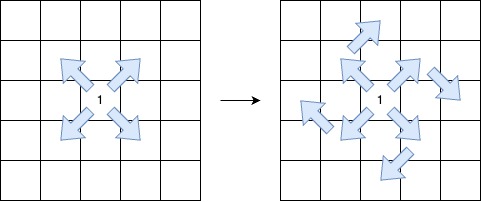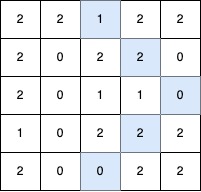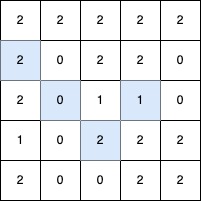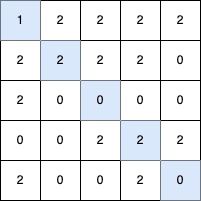LeetCode in Kotlin
3459. Length of Longest V-Shaped Diagonal Segment
Hard
You are given a 2D integer matrix grid of size n x m, where each element is either 0, 1, or 2.
A V-shaped diagonal segment is defined as:
- The segment starts with
1. - The subsequent elements follow this infinite sequence:
2, 0, 2, 0, .... - The segment:
- Starts along a diagonal direction (top-left to bottom-right, bottom-right to top-left, top-right to bottom-left, or bottom-left to top-right).
- Continues the sequence in the same diagonal direction.
- Makes at most one clockwise 90-degree turn to another diagonal direction while maintaining the sequence.

Return the length of the longest V-shaped diagonal segment. If no valid segment exists, return 0.
Example 1:
Input: grid = [[2,2,1,2,2],[2,0,2,2,0],[2,0,1,1,0],[1,0,2,2,2],[2,0,0,2,2]]
Output: 5
Explanation:

The longest V-shaped diagonal segment has a length of 5 and follows these coordinates: (0,2) → (1,3) → (2,4), takes a 90-degree clockwise turn at (2,4), and continues as (3,3) → (4,2).
Example 2:
Input: grid = [[2,2,2,2,2],[2,0,2,2,0],[2,0,1,1,0],[1,0,2,2,2],[2,0,0,2,2]]
Output: 4
Explanation:

The longest V-shaped diagonal segment has a length of 4 and follows these coordinates: (2,3) → (3,2), takes a 90-degree clockwise turn at (3,2), and continues as (2,1) → (1,0).
Example 3:
Input: grid = [[1,2,2,2,2],[2,2,2,2,0],[2,0,0,0,0],[0,0,2,2,2],[2,0,0,2,0]]
Output: 5
Explanation:

The longest V-shaped diagonal segment has a length of 5 and follows these coordinates: (0,0) → (1,1) → (2,2) → (3,3) → (4,4).
Example 4:
Input: grid = [[1]]
Output: 1
Explanation:
The longest V-shaped diagonal segment has a length of 1 and follows these coordinates: (0,0).
Constraints:
n == grid.lengthm == grid[i].length1 <= n, m <= 500grid[i][j]is either0,1or2.
Solution
import kotlin.math.max
class Solution {
private val ds = arrayOf<IntArray>(intArrayOf(1, 1), intArrayOf(1, -1), intArrayOf(-1, -1), intArrayOf(-1, 1))
private val nx = intArrayOf(2, 2, 0)
private lateinit var grid: Array<IntArray>
private var n = 0
private var m = 0
private lateinit var dp: Array<Array<Array<IntArray>>>
fun lenOfVDiagonal(g: Array<IntArray>): Int {
this.grid = g
this.n = g.size
this.m = g[0].size
this.dp =
Array<Array<Array<IntArray>>>(n) { Array<Array<IntArray>>(m) { Array<IntArray>(4) { IntArray(2) } } }
for (d1 in dp) {
for (d2 in d1) {
for (d3 in d2) {
d3.fill(-1)
}
}
}
var res = 0
for (i in 0..<n) {
for (j in 0..<m) {
if (g[i][j] == 1) {
for (d in 0..3) {
res = max(res, dp(i, j, 1, d, 1))
}
}
}
}
return res
}
private fun dp(i: Int, j: Int, x: Int, d: Int, k: Int): Int {
if (i < 0 || i >= n || j < 0 || j >= m) {
return 0
}
if (grid[i][j] != x) {
return 0
}
if (dp[i][j][d][k] != -1) {
return dp[i][j][d][k]
}
var res = dp(i + ds[d][0], j + ds[d][1], nx[x], d, k) + 1
if (k > 0) {
val d2 = (d + 1) % 4
val res2 = dp(i + ds[d2][0], j + ds[d2][1], nx[x], d2, 0) + 1
res = max(res, res2)
}
dp[i][j][d][k] = res
return res
}
}

